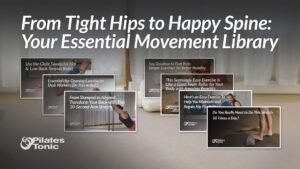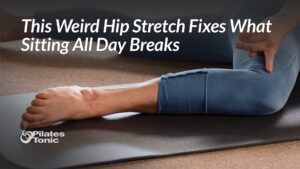One day, back when my daughter was five years old, I remember her sitting at our kitchen table, slouched over, getting ready to eat. Being the Pilates instructor that I am, I asked her to try and sit up taller.
Inquisitively, she asked me why.
I paused before I answered. I'd already learned that details about the biomechanics of the body and Pilates principles put her to sleep, or sent her running to another room.
I thought about what would make the most sense to her. The answer came to mind and out of my mouth quickly, “Because if you sit like that all the time, your body will grow that way.” I could tell my answer resonated with her and I could see her processing it. She got it.
That was four years ago. I knew my answer to her was true then, but at the time I really didn’t fully understand the reason.
I have been having a-ha moments right and left since returning from the Fascial Fitness™ workshop in January. Here's a big one I've wanted to share—it's a story about the relationship between fascia and water.
The critical function of hydration on movement has occupied my thoughts a lot lately. This is one of the most important things to understand about your fascia and I think it will motivate you to maintain greater awareness of you're movement behavior once you understand it. It sure made me re-think my movement habits!
Fascia is predominately made up of free-moving and bound water molecules. The body itself consists of up to two thirds water, as does our fascial structure.
You’ve probably heard that it's important to, “drink water and stay hydrated” because we're practically made of water.
While it's important to drink water and stay hydrated, there is a BIG, secondary component to that idea that's completely missing and which no one ever mentions when it comes to hydrating the body.
If you skip this component, you can drink all the water in the world and still miss out on the hydration benefits for your fascia because you’ll just pee and sweat it right out.
I'll tell you what it is in a second, but first you have to understand a key concept about your fascia.
The consistency of fascia is like mucous. Mucous can either be dried out and bind/stick together, or it can be moist and have a lubricating and “sliding” quality to it.
I know this may sound a little gross, but essentially we are all wearing mucousy bodysuits. And you want your mucous suit to be moist and have a sliding and gliding quality, not a sticky-and-dry-like-cotton-candy quality.
So, if drinking water isn’t the key to hydrating your fascia, what is?
The simple answer is movement.
Fascia is a hydrodynamic tissue. Hydrodynamics is the study of liquids in motion. The keyword here is motion.
Think about a kid's swimming pool that has filled with rainwater on a hot summer day and left sitting for a week or two. What happens to that water?
It becomes stagnant. Mosquitoes lay eggs in it. Bacteria grow in it and overall it becomes unfit to use at all.
But imagine if that water is stirred around, moved by more rain filling the pool, and older water is pushed out, the pool of water is circulated and stays fresh.
Our fascial structure is hydrated and refreshed by movement. When we move certain ways water is squeezed out of our fascial tissues like a sponge. Which then allows our fascia to reabsorb new “fresh” water from within our bodies.
If we only move in a few particular ways and don’t vary our movement on a regular basis, our fascial structure can become dehydrated and parts may become like the stagnant water in that swimming pool on a hot summer’s day. When this happens we are more prone to injuries and inflammation.
We’ve got to move our bodies. Movement hydrates.
So to bring it back to the answer I gave my daughter that day. If we are sitting slouched over hour after hour, day after day, eventually the fascial structure in our upper body loses its sliding/gliding quality and becomes sticky, stagnant and stiff.
When this happens, sitting up tall becomes much more work, more fatiguing and uncomfortable. This sets the scene for the muscles and bones to follow.
So my answer was true. If you slouch or have poor postural habits, you will grow that way. Yikes!
The good news is that it is possible to create an entirely new fascial structure through movement and consistency. And you can do it in as little as six months or as much as two years depending on where you're starting.
The really good news? AGE DOESN’T MATTER! 🙂
Additional Fascia Workshop Date
So, guess what? If you were wondering to yourself just now, “Hey, how can I get a list of the top movements I should be doing every day to make sure my fascia is hydrated and healthy and my body is growing in the best possible direction?” you're in luck! (You were wondering that, right? 😉 )
The workshop I'll be teaching on February 8 is full, but If you are interested in attending, I've added a second free fascia workshop on Wednesday, February 27 from 6:45 – 8:00 pm.
I’ll be discussing about how training your fascial structure works as well showing some exercises you can incorporate into your activities that will help you develop a new fascial structure that will serve you for the rest of your life.
I’m really looking forward to sharing more about the specific movements you want to be making to help get you on the road to creating a healthy fascial structure in your body.
You can register for the February 27th Fascia Workshop here…
See you at the studio,
Sydney









10 Responses
I love what you write. You are so generous to share this information. Thank you.
Have you ever thought of making this fascia workshop available online? I live in Florida and I’m unable to make it to your studio, although I hope to one day.
Hi Tammy, An online class or workshop is a possibility…especially when I know it’s something that would be helpful and people are interested. Thank you for your feedback. It’s very helpful! I’m so glad you enjoyed the post. 🙂
Very informative just what I needed to hear
Excellent! Thanks Troy!
Great post, Sydney! It’s information like this that has made it more clear why massage therapists will say to drink a lot of water after a lot of deep tissue work.
Might be worth mentioning in follow-up posts that the physical practice of yoga through asana—in which modern Western practice was significantly influenced by Pilates—is a great way to achieve well rounded movement. Especially so with styles like Iyengar, that make yoga more accessible to many people, including the elderly, those with disabilities, or those recovering from injuries. =)
Thanks for your feedback Dominick!
One of the most accurate articles about this subject. Actually the only one that makes sense and has logic
Excellent!
YogaDudeXXI
Thanks YogaDudeXXl!
Great post. I now have a better understanding of fascia. Thxs
Glad this post was helpful. Thanks for your feedback!